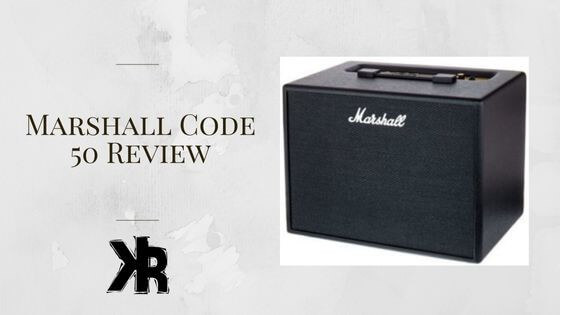Table of Contents
The Marshall Code 50 is a DSP based modeling amplifier that can easily emulate over 14 classic Sounds. This combo amplifier has a 12″ speaker built in, as well as headphone and auxiliary jacks to expand its versatility.
Marshall has finally brought their version of a DSP amplifier to the market with the Code line.
It comes in many different power options, but today we will be looking at the 50 watt version. Built in digital power amps, cab emulation and effects make this amp one powerful tool for guitar players!
Features
Let’s take a look at some key features of the Marshall Code 50.
- 14 Marshall tube amp sounds.
- Combo with one 12″ speakers.
- 24 Built-In effects.
- Built-in power amp and cab emulations.
- Aux and phone jacks.
- 50 watts of power.
- Bluetooth.
- Marshall gateway software.
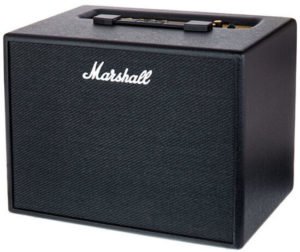
Who Is This Amp For?
At 50 watts, this amplifier can serve many musicians well. I would suggest that beginners, students, and intermediate players can benefit from it.
If you’re a Marshall fan, then these tones will satisfy your desire. Plus, it has effects built in to provide even more versatility among the many amp models.
Benefits
I found that the amplifier was a very handy tool when it came to recording. The sounds it provided direct were some of the best I have heard from DSP amps.
I was also impressed with the power output. Not only can this amp be used for practice and recording, but gigs as well.
When performing with my band, the Code 50 was able to keep up with our hard hitting drummer. This isn’t easy to do! But the amp was able to cut through the mix and stay present in the sound.
Drawbacks
The first drawback for me was the fact that there is no foot switch included. For an amplifier at 50 watts, you would expect one to be included.
I use many different sounds when I play with my band, like clean and distortion. I need to be able to switch between them on the fly. To me, this is a drawback.
Code 50 Score
Overall
-
Build Quality
-
Sounds
-
Versatility
-
Ease of use
Sound Performance
Marshall is a company with a long-standing reputation for their iconic sound. And has once again delivered with the Code 50 amplifier!
Despite initial skepticism upon unboxing, this amp exceeds expectations. It has top-notch sounds that rival higher-priced competitors.
Featuring popular Marshall preamps like the 800, Jubilee, and JTM45. The Code 50 delivers fantastic, authentic tones. They are sure to impress any musician.
Its ability to customize preamps, power amps, and cab emulations allows for endless possibilities. This makes the amplifier a powerful and exciting platform.
Not only is it powerful, but it’s also incredibly user-friendly! With easy-to-navigate controls that guarantee a satisfying experience. The clean sounds are especially noteworthy when paired with effects. And the 50 watts of power provide perfect headroom for any performance.
Additionally, the effects on the amplifier are impressive! They offer satisfactory performance for the amp’s price range.
Overall, the Code 50 delivers excellent sounds that are very close to a Marshall tube amp. The video below provides great sound clips for you to experience it firsthand.
PROS
- Solid build and design.
- Quality materials.
- Good sound for price point.
- Lush clean channel.
- Built-In effects.
- 50 watt output.
CONS
- Not an exact representation of Marshall tube amps.
- Bluetooth issues at times.
- No line out.
Construction
The Marshall Code 50 is a 28 LB combo amp, measuring 20.8″ wide, 17.3″ high, and 11″ deep. It has one 12-inch speaker in a wooden closed-back enclosure.
It’s finished in classic Marshall Tolex and grill cloth. The enclosure as a whole is very rigid and will endure gigs and travel.
The controls are right on top of the amplifier and are laid out in an intuitive manner. The buttons feel good, and all controls are of good quality.
Nothing feels cheap when used. Being placed on the top, the controls are out of harms way. Especially if the amp is used for tours or shows and will be thrown around.
Buttons and an LCD screen open up the settings and functions of the Code 50. This allows the user to easily configure the amplifier and adjust it to taste. All hardware feels like quality parts and responds very well when toggled.
The headphone jack and Aux IN are both 1/8″ and are located on the top of the amplifier for ease of use. There is also a USB connector on the top of the amplifier to access the software. All through a computer or other device, as well as record or control the amp with MIDI.
The amplifier is quite light for a combo with a 12″ speaker. It’s easy to carry with the top-mounted strap handle. Overall, it’s solid construction, which is what we would expect from Marshall!
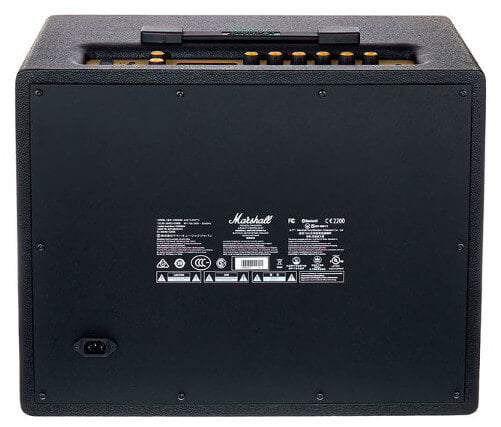
Channels and Controls
The Code 50 is a modeler and has a similar layout to other popular amplifiers. If you have ever used another modeler, then you will recognize the similarities of a digital amp here.
The amplifier comes with a built-in LCD screen. All selections are made with buttons and a rotary edit control. This keeps things pretty simple and clean on top, which is great if lots of controls overwhelm you.
Effects on the Code 50 consist of Modulation effects, Delay, and reverb. Also, Wah plus stomp box distortion emulations.
These can also be controlled and edited using the Marshall gateway app. It can also be used via Bluetooth, which is a really slick control scheme!
The USB connection on the top of the amplifier will allow you to connect to a computer to do a few different things.
This connection will allow you to use the Marshall gateway app. But it will also allow you to connect to a DAW and record direct!
This is a great feature as the amplifier already has a built-in power amp and cab emulations. The USB connection also lets you update the firmware or control with MIDI.

Output Power
The Marshall Code is rated at an output power of 50 watts, and man does it deliver! The power is right on with a heavy-hitting drummer and cuts through the mix very well.
The nice thing about this amp is that there is plenty of power on tap, and you don’t have to crank it. I find that when it is cranked, it gets a bit loose in the bass.
But thanks to the power output, it sounds good in a band setting and has plenty of headroom!
Recording Quality
Our choice of software this time around was Reaper. And to my surprise, we got a pretty good guitar sound when recorded directly from the USB.
To be honest, of all the modelers we review, this is one of the better amps in terms of sound and responsiveness.
I also tried using the headphone jack out to Reaper, but it wasn’t quite as nice sounding as the USB. Overall, this amp records direct really well!
Built-In Tuner
The Marshall Code 50 has a built-in tuner, which should be expected in a modeler. Its LCD makes it one of the easier tuners to use.
Simply hold the PRE FX and AMP buttons and the display will change to its tuner. From there, simply pluck a string and the display will let you know if it needs to be adjusted or not. I am also happy to report that the tuner is accurate!
Noise Gate
One of the really cool features of the amp that often gets overlooked is a built-in noise gate! Most of the factory presets have this feature enabled. But depending on the setting, this might make it sound funny.
So make sure to access and set this feature to taste. It can either be a powerful feature, or a dealbreaker if not set right. Some of the presets are noisier than others. So the gate helps with the signal-to-noise ratio!

Notable Alternatives
If the Marshall Code 50 just isn’t our thing, there are many other great options on the market. Here are a few of my favorites that are similarly priced.
Boss Katana MK2
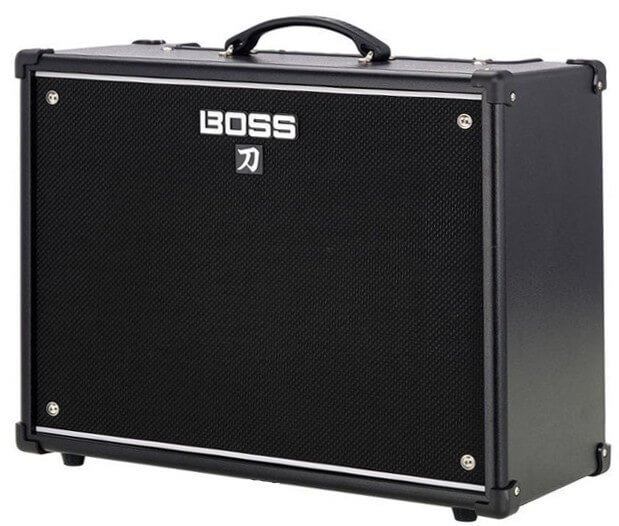
A difficult amplifier to beat is the Boss Katana. The functions are useful, and the audio is superb. Both novice and advanced players will benefit greatly from this amp. Due to the excellent voicing work of Boss, it’s a very popular choice.
It is also incredibly versatile because it offers the choice of acoustic models. This provides you access to an enormous variety of sounds, and it’s quite economical. For more information, read the complete review we wrote about this amplifier.
Vox VT40X
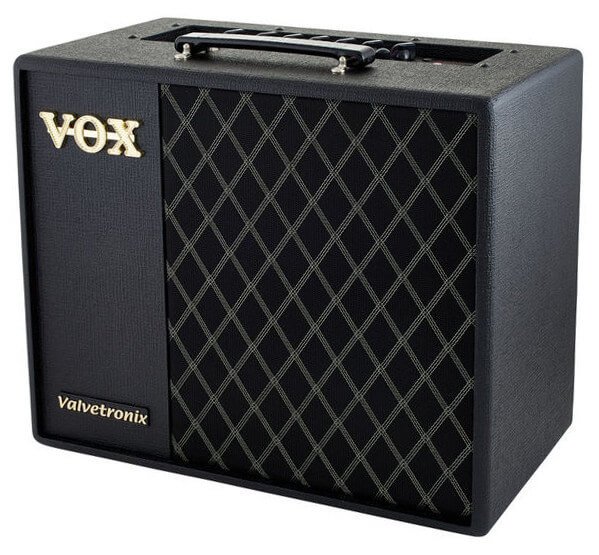
There is also the excellent Vox VT40X. To produce models with good sound quality, they combine tube and DSP technologies. The amplifier includes a number of effects in addition to 11 tube amp sounds. It can produce 40 watts and easily keep up with a drummer.
In addition to being constructed like a tank, it also offers USB recording capabilities. This allows you to utilize it for straight recording, but also gigging. It’s an amplifier with many of uses. Click the button below to read my full review.
My Thoughts on The Code 50
Getting a good sound from the amp right away was promising, and it did impress me overall! The included Gateway software gives you access to the amp that is not like the front panel. This will allow you to set up the amp truly to taste!
The use of Bluetooth is a huge advantage and makes using this amp easy! So if you are looking for an amplifier that can fill many roles, the Code is what you need.
Marshall has also designed a foot switch to work with their Code line of amplifiers. It is sold separately. Do you need the versatility of switching the amp while performing? Then foot switch is affordable and easy to use!
If 50 watts are not enough, or perhaps too much power, Marshall also makes a Code 25 and a 100! You are sure to find what you need in the Code line of amplifiers!
Overall, I like the Code 50 and feel the sounds are quite good. The frequency response was quite balanced, but I did feel there was a lack of bass.
But I don’t expect the Code 50 to respond like a true tube amp. Even the speaker it comes with doesn’t seem to be able to handle a deep bass. But it’s still good value for the money.
FAQs
Does it come with a foot switch?
No, the Code 50 doesn’t come with a foot switch. This is one of the drawbacks with the amplifier in my opinion. The foot switch is sold separately and is reasonably priced. But I believe that it should have been included.
Does the Code 50 take effect pedals well?
I used the Code 50 with distortion and effect pedals, and it took them well. I used them right into the front input to see how it would handle them.
They sound just fine and worked flawlessly. This increased the range of sounds that were possible to me, as I have pedals that I like more than what is on board.
Is the Code 50 a tube amp?
No, the Marshall Code 50 is a DSP modeler. Its sounds have been created around Marshall tube amps. But the Code line of amps are not tube based.
Does the Marshall Code 50 have an effects loop?
The Code 25 and 50 do not have effects loops. If you want to use your favorite stomp effects, it will have to be fed into the front input.

